Originally Posted At: https://breakingmuscle.com/feed/rss
Imagine this: It’s peak hour at your gym and you’ve spent all day looking forward to attacking some front squats, but the wait for a squat rack is longer than the line at the smoothie bar on half-price day. Or maybe you’re trying to get a quality workout in a sparse hotel or still-growing home gym. Perhaps you just need a new squat variation for your program.
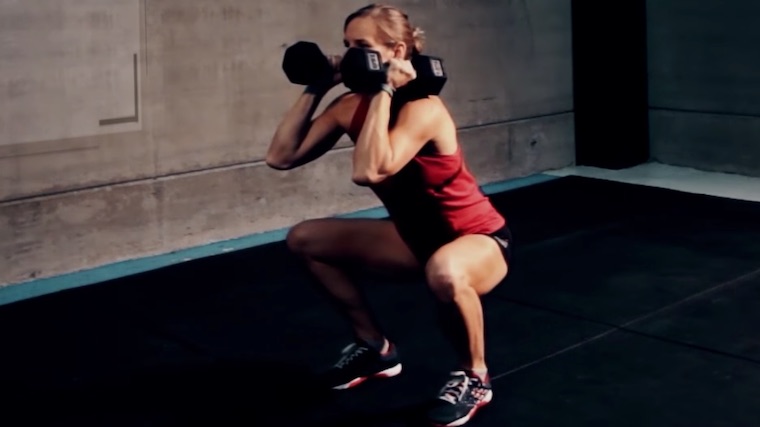
Consider the dumbbell front squat. It requires only a pair of dumbbells and minimal floor space. More importantly, it builds killer quadriceps, a strong upper back, and a solid core. This article teaches you how and why to perform and program the dumbbell front squat.
Dumbbell Front Squat
- How to Do the Dumbbell Front Squat
- Dumbbell Front Squat Mistakes to Avoid
- How to Progress the Dumbbell Front Squat
- Benefits of the Dumbbell Front Squat
- Muscles Worked by the Dumbbell Front Squat
- How to Program the Dumbbell Front Squat
- Dumbbell Front Squat Variations
- Frequently Asked Questions
Complete Dumbbell Front Squat Tutorial
See the detailed dumbbell front squat video instructions from Dr. Merrick Lincoln, then check out the step-by-step breakdown below.
How to Do the Dumbbell Front Squat Step By Step
The dumbbell front squat is a front squat alternative performed with a dumbbell racked on each shoulder. Follow these step-by-step instructions to ensure proper form.
Step 1 — Clean the Dumbbells
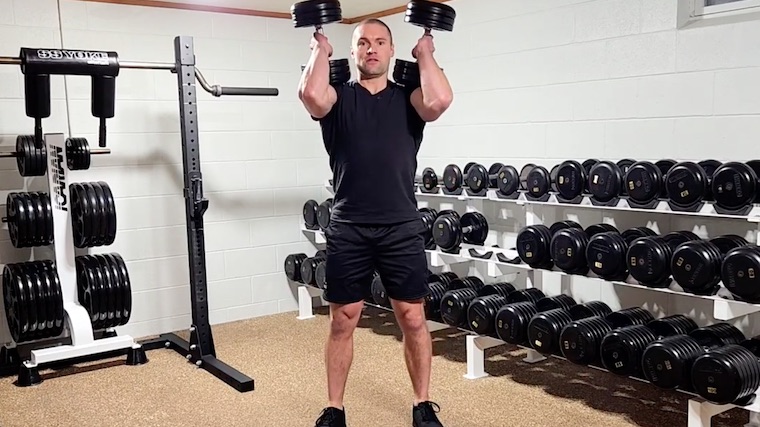
Before you squat, you must “front rack” the dumbbells. In the front rack position, the ends of the dumbbells rest atop your shoulders and your elbows point straight ahead at shoulder-height.
To set up the front rack, perform a dumbbell clean — Start with the dumbbells at your sides. Drop into a mini-squat and rapidly extend your legs by driving your feet into the ground. Transfer the leg push into a powerful shrug. At the top of the shrug, draw your arms along your sides. Drop underneath the dumbbells by re-bending your legs and receive the weights atop your shoulders with your elbows high and bent. (1)
Form Tip: When cleaning heavy dumbbells, it may be helpful to think about “jumping” up with the dumbbells to propel them into the front rack. Although you should barely leave the ground, “jumping” the dumbbells into position can improve output and fluidity of the clean.
Step 2 — Set Your Stance and Brace
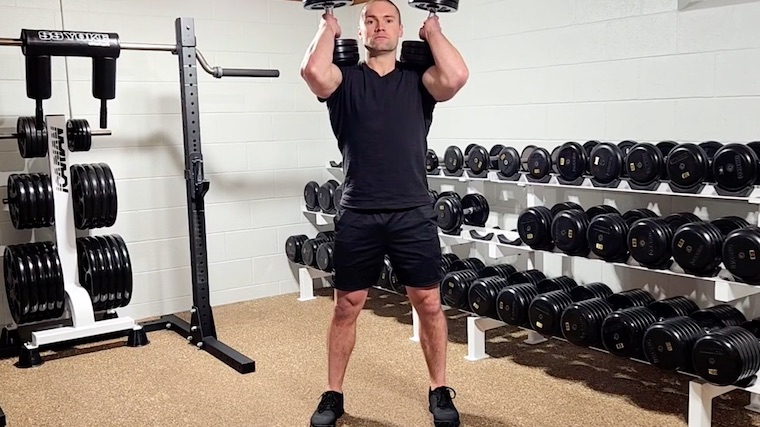
With dumbbells racked, place your feet at your preferred squat width and orientation. Typically, the front squat stance is shoulder-width or slightly wider. Your feet should point straight ahead or slightly outward. Brace your midsection by contracting your abdominals and back muscles at the same time.
Form Tip: Set up a strong foundation by achieving pressure through your heel, the ball of your foot, your big toe, and the base of your fifth toe. Basically, keep weight on your entire foot throughout the exercise without overemphasizing either your heels or the ball of your foot.
Step 3 — Lower to the Bottom Position
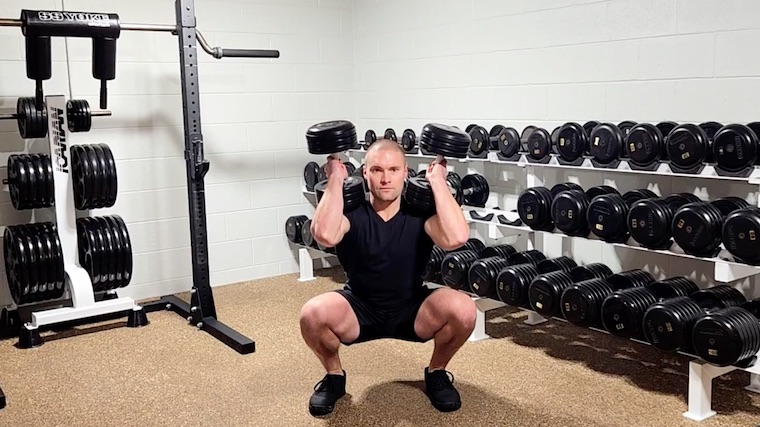
While keeping a straight or slightly arched back position, lower yourself toward the floor by allowing your knees, hips, and ankles to bend. Descend with control. Resist bouncing out of the bottom of the squat. Also, avoid “cutting depth” (i.e. ending the descent before you’ve reached maximum comfortable knee bend with good control).
Form Tip: Achieve proper dumbbell front squat form by squatting “down” not “back.” This is not a powerlifting-style back squat that calls for a forward lean to improve leverage and move heavy weights. Your upper body should remain more upright.
Step 4 — Stand Up to Lockout
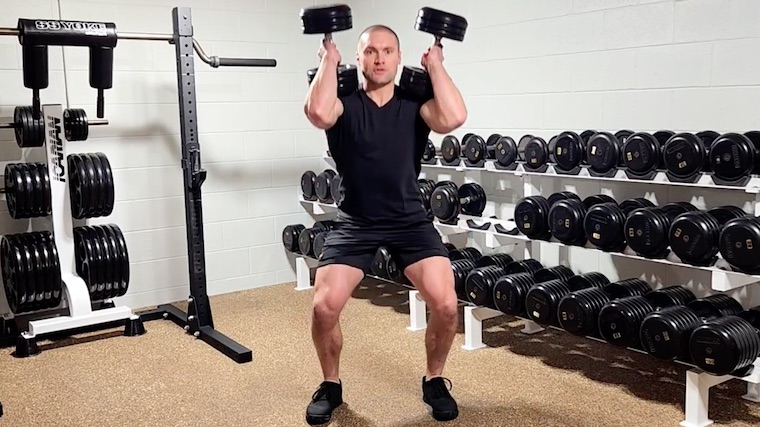
Reverse the movement of your knees, hips, and ankles by standing tall. Keep the dumbbells balanced on your front delts throughout the movement. At the top, take a breath and re-brace your core before repeating another repetition. Don’t lower the weight from your shoulder until you’ve completed all reps.
Form Tip: As you push back to the standing position with forceful intent, think about driving the dumbbells toward the ceiling or sky but don’t actually lift them off your shoulders. This external cue can promote a strong front rack and improve power output. (2)
Dumbbell Front Squat Mistakes to Avoid
Steering clear of several common errors may help to maintain effectiveness and safety of the dumbbell front squat.
Allowing Your Elbows or Chest to Drop
The common barbell front squat cue applies just as well to the dumbbell front squat — “Chest up, elbows up.” Failure to maintain a high elbows position and a proud chest result in the dumbbells traveling forward. Too much forward movement of the dumbbells may result in compromised training stimulus for the quadriceps and even repetition failure with a loss of balance.
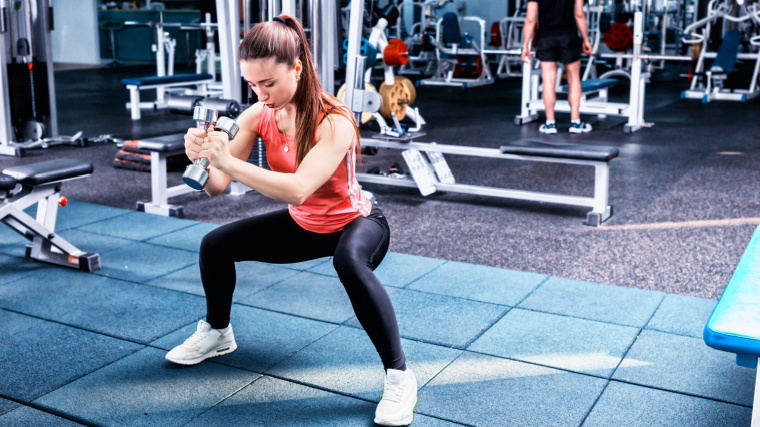
Avoid it: Most of the dumbbells’ weight should rest on your shoulders, not your hands. Keep the weight in contact with your shoulders throughout the exercise. Don’t try to support the weight “freely” by holding your hands in the top of a biceps curl.
Low Back or Trunk Leaning Excessively Forward
Losing form at your hips or low back can cause all sorts of problems during the dumbbell front squat. These include, but are not limited to, loss of stability, your heels coming off the floor, and needlessly failed repetitions.
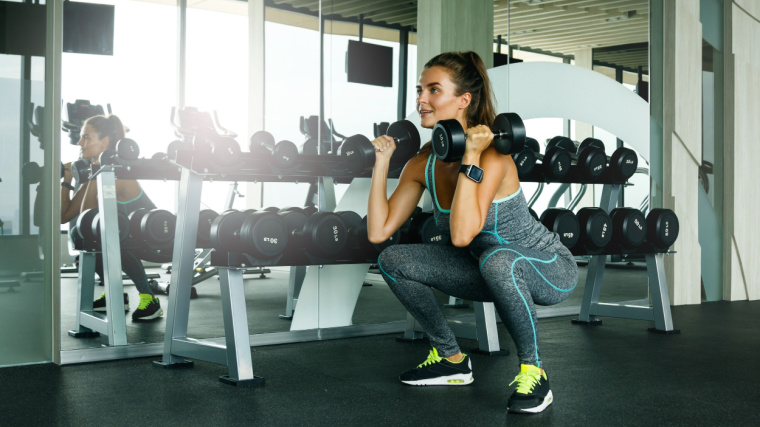
Avoid it: To correct or prevent this, reminding yourself to brace and squat down rather than back is a good start, but it might not be enough. Among lifters without orthopedic limitations (i.e. lifters without stiff joints or obvious weaknesses), a coordination deficit can be to blame for excessive forward motion of the trunk or low back. (3) Check out the “overhead squat RNT” exercise in the FAQs section for a potent corrective exercise.
Insufficient Depth
Squats lacking depth? You can’t rely on your good looks and charm to fix this problem. If you are consistently cutting depth in the dumbbell front squat, your muscle development may suffer. Deep squatting has been shown to result in greater quadriceps muscle growth than shallow squatting. (4)

Furthermore, Kubo and colleagues reported full squat training resulted in more than twice the glute and adductor hypertrophy compared to half squatting. (5)
Avoid it: Many lifters without orthopedic limitations can improve their squat depth by repetitive practice focused on achieving “hamstrings touching calves.” If ankle flexibility is limiting your squat depth, consider the heels-elevated variation discussed below.
How to Progress the Dumbbell Front Squat
Lifters new the dumbbell front squat should begin with light weights to hone technique. Once this honeymoon phase is over, it’s time to go heavier and higher rep to promote strength and hypertrophy.
Increase the Weight
Once the exercise form is familiar and consistent, load progression to a “working weight” is in order. Establishing your working weight does not necessarily require repetition maximum testing.
A simple progression method is to determine a repetition range target based on your goals (explained in the Programming section). Then, work up to a weight that results in a challenging set that allows you to complete a number of repetitions near the bottom end of your target range. For example, if your repetition target for hypertrophy training is 8 to 12 repetitions, identify a weight that allows less than 10 repetitions.
Increase the Repetition Volume
As you get stronger with a particular pair of dumbbells, perform additional repetitions per set. Using the weight you identified above, you might be able to perform additional repetitions within a few weeks. Once you reach the upper end of your repetition target (e.g. 12 reps in the above example), it is time to increase weight again.
Benefits of the Dumbbell Front Squat
The dumbbell front squat is a unique squat variation that biases the thigh muscles while requiring only light to moderately heavy loads, which are comfortably supported atop the shoulders.
Quadriceps Muscular Growth
The placement of the load in front of the body during the dumbbell front squat promotes a “knee dominant” squat by facilitating greater forward knee travel and a more upright trunk position. (6) (7) “Knee dominant” means this variation loads the quadriceps to a relatively greater extent than variations where the load is held on the back, such as traditional back squats.
Consistently performing a squat variation that biases the quadriceps will build the “quad sweep” many aesthetic-focused lifters are seeking. The dumbbell front squat may be a particularly effective quadriceps-builder, because it trains the quadriceps through a large range of motion. (4)(8)
Spares the Low Back
The dumbbell front squat might be a friendly option for those dealing with low back pain or local muscle fatigue. The upright trunk angle diverts load from the low back and hips to the knees. (7) Reduced overall load used during the dumbbell front squat is also likely to reduce mechanical demand on the low back compared to other common squat variations that use heavier loads.
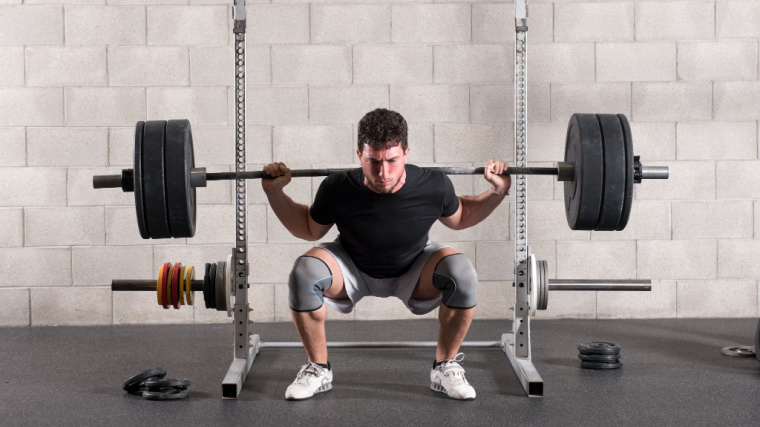
For example, compared to back squats, barbell front squats resulted in reduced spinal compression forces when performed at the same relative intensity. (9) The difference may be partly attributed to differences in overall load, since participants in this research squatted more than 25% more weight during back squats than front squats. (9) Naturally, the heavier squat imposed more overall stress.
Dumbbell front squats undoubtedly have a lower loading capacity than barbell front squats, so the demand on the low back is likely even lower. Give this squat variation a try when you low back feels “fried.”
A Forgiving Front Rack
Compared to the traditional front squat, the front rack position of the dumbbell front squat requires less shoulder, wrist, and elbow flexibility. Holding the barbell for the traditional front squat requires considerable shoulder external rotation, elbow flexion, and wrist extension.
Albeit barbell front squat variations such as gripless (i.e. “zombie”) front squats and cross-arm front squats avoid the challenging upper body positions of the barbell front squat. (10) But these gripless and cross-arm variations tend to place uncomfortable pressure on the deltoids or collarbones and may feel awkward.
Muscles Worked by Dumbbell Front Squat
Like any squat, the primary lower body actions resisted by the dumbbell front squat are knee extension, hip extension, and ankle plantar flexion. However, the unique setup and execution of the dumbbell front squat may make this variation more “knee dominant,” biasing the quadriceps. (6) Trunk muscles deserve an honorable mention for their involvement in the dumbbell front squat, as these muscles facilitate proper form.
Quadriceps
For aesthetics and function, the four muscles comprising the quadriceps are undoubtedly the most important muscles of the thigh. Although rectus femoris may experience little to no hypertrophy with squat training, squats promote substantial hypertrophy of the other three quad muscles: vastus medialis, vastus lateralis, and vastus intermedius. (5)(11) Fortunately, these muscles form the “quad sweep” many aesthetics-focused lifters desire.
Glutes and Other Hip Extensors
The “glutes” — gluteus maximus, gluteus medius, and gluteus minimus — are trained as hip extensors during the dumbbell front squat. The hamstrings are marginally active during the squat as hip extensors and also act to counteract shear forces at the knee. (8)(9) Research suggests the adductors, or inner thigh muscles, are also trained as hip extensors during the squat. (5)
Postural Muscles and Core
The dumbbell front squat hits postural muscles such as the spinal erectors, trapezius, and soleus (a deep calf muscle). To maintain a “braced” midsection during the squat, co-contraction of the abdominal muscles is necessary, which promotes a strong core.
How to Program the Dumbbell Front Squat
While it’s true the setup and execution of the dumbbell front squat limits maximum loading relative to barbell-based squats, appropriate programming of this exercise can deliver results. Specifically, lifters can program the dumbbell front squat for muscle gain (“hypertrophy”), strength, or as part of a deload from heavier squat variations.
Low to Moderate Weight, Moderate to High Repetitions
An exciting feature of training for muscular hypertrophy and muscular strength is that high effort sets, or those carried to- or close to- the point of muscular failure, are effective using practically any weight. (12)(13)(14) This is particularly relevant for an exercise like the dumbbell front squat.
Due to the constraints of setup (the initial dumbbell clean) and equipment (dumbbells), the dumbbell front squat cannot be loaded particularly heavy, at least not relative to the capacity of the leg muscles of experienced lifters. Whether you’re training for strength or size, select dumbbells that allow safe setup and proper form, and then take that set to within two or three repetitions of failure. Two to four sets of eight or more repetitions will promote strength and size, if each set is taken to close proximity to failure.
Moderate Weight, Moderate Repetitions
A deload refers to temporary reduction in training to promote recovery. The dumbbell front squat simply cannot be loaded as heavy as a barbell-based squats. This is due, in part, to the use of dumbbells which offer less stability and lower loading potential than a barbell. Note: the front-loaded nature of the exercise also limits loading potential relative to back squats. (9)
Therefore, even a somewhat challenging dumbbell front squat workout is likely to provide some degree of reprieve or recovery for intermediate and advanced lifters. Two or three sets of four to eight repetitions might serve as a nice deload week squat protocol.
Dumbbell Front Squat Variations
The dumbbell front squat isn’t the only way to perform an anteriorly loaded squat with dumbbells. Depending on your goals, preferences, and equipment, you might choose one of the following:
Heels-Elevated Dumbbell Front Squat
Performing squats on a wedge can be helpful to further bias the quadriceps or work around ankle dorsiflexion range of motion issues. (6)(7)(15) The wedge or heel lift projects your lower leg forward at the ankle’s resting position, reducing the need for additional dorsiflexion. (15)
When squatting with your heels elevated, your trunk tends to stay more upright and your knees travel further forward. Together, these features promote greater focus on the quadriceps (due to increased knee action). (6)(7)
Dumbbell Goblet Squat
Goblet squat — not “goblin” (this isn’t Middle Earth). The traditional goblet squat uses a kettlebell to reinforce deep squatting mechanics with an upright torso. If you don’t train with kettlebells, a dumbbell works just as well.
Goblet squats are performed with the weight held under the chin, as if it were a large drinking glass (“Lord of the Rings” fans, think of a vessel Dwarves would drink from in the Mines of Moria). Keep your elbows tight to your ribcage and squat down between your legs.
Dumbbell Zercher Squat
This unique variation was popularized by strength coach Nick Nilsson. The term “Zercher” refers to the carriage position of the dumbbell. It rests on your arms at, or just in front of, your elbows.
Hold the dumbbell vertically with your arms in front of your body. If you are unable to squat deep enough to retrieve the dumbbell from the floor during setup, simply place the dumbbell on a stable bench or box and retrieve it from there. Your arms must remain close to your trunk with your elbows flexed. Like the dumbbell front squat, keep your trunk upright as you squat with your feet flat on the floor.
Dumbbell Squat
The dumbbell squat uses two dumbbells held with your arms hanging alongside your body. (8) While this variation avoids cleaning or muscling dumbbells to the rack position, it may not promote as upright of a trunk position as other front-loaded variations.
The dumbbell squat feels a little like a trap bar squat, albeit with a lower loading potential. Altogether, the dumbbell squat may be a great option for those looking for a user-friendly variation that promotes hip-, thigh-, and grip development.
FAQs
That’s an option. Both exercises build leg size and strength while placing the load in front of your body. In fact, muscle activity levels for most of the primary muscles are similar between dumbbell front squat and barbell front squats when the same load is used. (16)
But there are substantial differences between the barbell front squat and the dumbbell front squat: upper body position, placement of the load, equipment requirements, and loading capacity, just to name a few. Ultimately, the choice of whether to front squat with the barbell or dumbbells should take these differences into consideration.
The dumbbell clean to the front rack position before squatting is the most technically demanding portion of the entire exercise. It can impose a bottleneck on weight progression.
But unless you’re using light enough dumbbells to curl or have a partner willing to lift the dumbbells to the front rack position for you, the clean is an intrinsic feature of the dumbbell front squat setup. The dumbbell Zercher squat and the dumbbell squat discussed in the Variations section allow you to avoid the clean.
Traditionally, your elbows are held high during the dumbbell front squat, as instructed. However, it is common to see the dumbbell front squat performed with lower elbows and the dumbbells parallel to the ground.
While it may be effective with lighter weights, the lower carriage position may limit loading capacity, as the dumbbells are held slightly further in front of the body. The higher elbow position may also help to encourage an upright and extended upper back position, which helps to develop postural strength and upper back muscle.
First, make sure the weight you are attempting to squat is appropriate for your current strength and ability. If you’ve tried reducing the weight and you’re still rounding forward and losing position, screen your ankle flexibility. Are you able to progress your knees over the front of your toes with your heels on the floor? If not, calf stretching, foam rolling, or ankle joint mobilizations may help. (3)
After ruling out loading errors and orthopedic limitations, the likely culprit is a coordination issue, specially deficient trunk control. Reactive neuromuscular training (RNT) is a broad class of interventions aimed at restoring coordination and dynamic stability. (17) A common RNT technique to address excessive forward lean or trunk “rounding” is the “overhead squat RNT” technique, shown in the video below.
Perhaps counterintuitively, a light challenge tending to pull the trunk forward can help improve position sense and coordination of the trunk during the squat. Although immediate improvements in squat form may occur, lasting benefits may result from performing this corrective exercise three or more days per week for two to four sets of 10 to 12 repetitions.
Just Another Anteriorly Loaded Thigh-Thickener?
Like its barbell-based brother, the dumbbell front squat places weight in front of the body. But unlike the barbell front squat, it doesn’t require extreme positions of the shoulders or wrists. And it doesn’t even require waiting for a squat rack. User-friendly and convenient, the dumbbell front squat is in a class of its own.
References
- Hedrick, A. (2015). Dumbbell power clean, front squat, and power jerk. Strength & Conditioning Journal, 37(3), 84-88.
- Nadzalan, A. M., et al. (2020). The effects of focus attention Instructions on the movement kinetics, muscle activation and performance during resistance exercise. In Journal of Physics: Conference Series (Vol. 1529(2), 022008.
- Bishop, C., & Turner, A. (2017). Integrated approach to correcting the high-bar back squat from “excessive forward leaning”. Strength & Conditioning Journal, 39(6), 46-53.
- Bloomquist, K., et al. (2013). Effect of range of motion in heavy load squatting on muscle and tendon adaptations. European journal of applied physiology, 113(8), 2133-2142.
- Kubo, K., Ikebukuro, T., & Yata, H. (2019). Effects of squat training with different depths on lower limb muscle volumes. European Journal of Applied Physiology, 119(9), 1933-1942.
- Barrack, A. J., et al. (2021). The relative orientation of the trunk and tibia can be used to estimate the demands on the hip and knee extensors during the barbell back squat. International Journal of Sports Science & Coaching, 16(4), 1004-1010.
- Fry, A. C., Smith, J. C., & Schilling, B. K. (2003). Effect of knee position on hip and knee torques during the barbell squat. The Journal of Strength & Conditioning Research, 17(4), 629-633.
- Graham, J. F. (2011). Exercise Technique: Dumbbell Squat, Dumbbell Split Squat, and Barbell Box Step-up. Strength & Conditioning Journal, 33(5), 76-78.
- Gullett, J. C., et al. (2009). A biomechanical comparison of back and front squats in healthy trained individuals. The Journal of Strength & Conditioning Research, 23(1), 284-292.
- Ronai, P. (2022). The Front Squat Exercise. ACSM’s Health & Fitness Journal, 26(2), 44-50.
- Schoenfeld, B. J. (2010). Squatting kinematics and kinetics and their application to exercise performance. The Journal of Strength & Conditioning Research, 24(12), 3497-3506.
- Schoenfeld, B., Fisher, J., Grgic, J., et al. (2021). Resistance training recommendations to maximize muscle hypertrophy in an athletic population: Position stand of the IUSCA. International Journal of Strength and Conditioning, 1(1), 1-30.
- Lasevicius, T., et al. (2018). Effects of different intensities of resistance training with equated volume load on muscle strength and hypertrophy. European journal of sport science, 18(6), 772-780.
- Spiering, B. A., et al. (2022). Maximizing Strength: The Stimuli and Mediators of Strength Gains and Their Application to Training and Rehabilitation. The Journal of Strength & Conditioning Research, 10-1519.
- Charlton, J. M., et al. (2017). The effects of a heel wedge on hip, pelvis and trunk biomechanics during squatting in resistance trained individuals. The Journal of Strength & Conditioning Research, 31(6), 1678-1687.
- Wu, H. W., et al. (2020). Effect of loading devices on muscle activation in squat and lunge. Journal of Sport Rehabilitation, 29(2), 200-205.
- Guido Jr, J. A., & Stemm, J. (2007). Reactive neuromuscular training: a multi-level approach to rehabilitation of the unstable shoulder. North American Journal of Sports Physical Therapy: NAJSPT, 2(2), 97-103.
Featured Image: Merrick Lincoln, DPT, CSCS / YouTube
The post How to Do the Dumbbell Front Squat for Leg Size and Strength appeared first on Breaking Muscle.
Filed under: Fitness

 For now classes are 6pm and 640pm at 2840 Wildwood st in the Boise Cloggers studio.
Book your class NOW!
click this ==>
For now classes are 6pm and 640pm at 2840 Wildwood st in the Boise Cloggers studio.
Book your class NOW!
click this ==>








